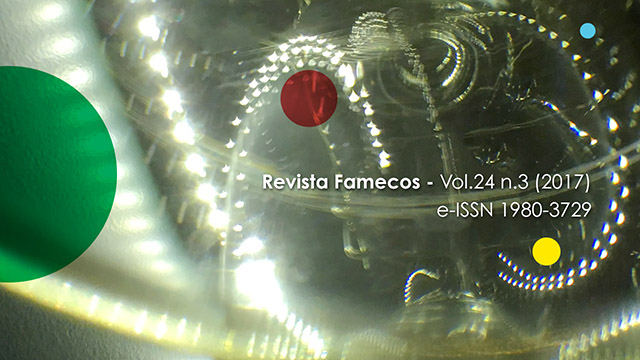Language, meaning and context: notes on communication and history
DOI:
https://doi.org/10.15448/1980-3729.2017.3.27047Keywords:
Context, Communication, HistoryAbstract
The article discusses the difficulties of thinking about the notion of historical context in the field of communicational research. We speak with propositions of language theories that reflect on language, its performative character and its materialization in the media, and the theory of history, especially the tradition that pursues continuities and discontinuities of a cultural history. Our discussion is based on two basic propositions: 1) the way in which the concept of context, understood automatically, imposes a referential quality to the historical text in the studies of the communicative phenomenon that exactly hides its communicational aspects; 2) The understanding that reversing the perception of the media as part of a socio-historical "background" to that of a "figure" of a cultural history can strengthen the reflection on historicity in the field of communication. Such a movement may contribute to the illusion of the context being transcended by a heuristic perspective in the field of communication research.
Downloads
References
AUSTIN, J. L. How to do things with words. Cambridge, Massachussets: Harvard University Press, 1962.
AUTHIER-REVUZ, J. Entre a transparência e a opacidade. Porto Alegre: Edipucs, 2004.
AUTHIER-REVUZ, J. Heterogeneidade(s) enunciativa(s). Cadernos de estudos lingüísticos, Campinas, UNICAMP – IEL, n. 19, jul./dez.,1990.
BAKHTIN, M. Estética da criação verbal. São Paulo: Martins Fontes, 1992.
__________. Problemas da poética de Dostoiévski. Tradução de Paulo Bezerra. 5. ed. Rio de Janeiro: Forense Universitária, 2010.
CERTEAU, Michel De. L’ecriture de l’histoire. Paris: Gallimard, 1975.
FOUCAULT, M. As palavras e as coisas: uma arqueologia das ciências humanas. São Paulo: Martins Fontes, 2006.
GAGNEBIN, Jeanne Marie. História e narração em Walter Benjamin. São Paulo: Perspectiva: Campinas: Editora da Unicamp, 1994.
GOMBRICH, E. H. Arte e ilusão: um estudo da psicologia da representação pictórica. São Paulo: Martins Fontes, 2007.
GUIMARÃES, César; FRANÇA, Vera. Experimentando as narrativas no cotidiano. ______. (Orgs.). Na mídia na rua: narrativas do cotidiano. Belo Horizonte: Autêntica, 2006.
gumbrecht, H. U. Modernização dos sentidos. São Paulo: Ed. 34, 1998.
______. Em 1926: vivendo no limite do tempo. Rio de Janeiro: Record, 1999.
HOUAISS, A. Dicionário Houaiss da Língua Portuguesa. Rio de Janeiro: Objetiva, 2001.
JAKOBSON, Roman. Lingüística e comunicação. São Paulo: Editora Cultrix, 2008.
LUHMANN, Niklas. A realidade dos meios de comunicação. São Paulo: Paulus, 2005.
PARRET, Herman. L’énonciation en tant que déictisation et modalisation, Langages. Paris: Walter de Gruyter GmbH & Co KG, 1983.
PINTO, Milton José. Comunicação e discurso: introdução a análise de discursos. São Paulo: Hacker Editores, 1999.
POPPER, Karl. O mito do contexto. Lisboa: Edições 70, 2009.
RANCIÈRE, Jacques. O conceito de anacronismo e a verdade do historiador. In: SALOMON, Marlon (org.). História, verdade e tempo. Chapecó: Argos, 2011.
RORTY, Richard. The linguistic turn. Recent essas in Philosophical Method. Chicago and London: The University of Chicago Press, 1967.
THOMPSON, John B. Ideologia e cultura moderna. Petrópolis: Vozes, 1995.
WHITE, Hayden. Metahistory: The historical imagination in the nineteenth-century Europe. Baltimore & London: The Johns Hopkins University Press, 1973.
______. Trópicos do discurso: Ensaios sobre a crítica da cultura. São Paulo: Edusp, 1994.
Downloads
Published
How to Cite
Issue
Section
License
Copyright
The submission of originals to Revista Famecos implies the transfer by the authors of the right for publication. Authors retain copyright and grant the journal right of first publication. If the authors wish to include the same data into another publication, they must cite Revista Famecos as the site of original publication.
Creative Commons License
Except where otherwise specified, material published in this journal is licensed under a Creative Commons Attribution 4.0 International license, which allows unrestricted use, distribution and reproduction in any medium, provided the original publication is correctly cited.






